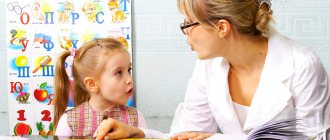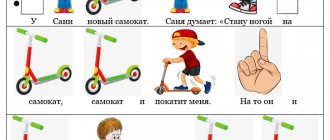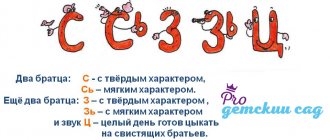Pros and cons of homeschooling
Some of the positive aspects of teaching reading at home include:
- Floating schedule. Mother and child do not need to rush, adapt to the schedule of the teacher or courses.
- Ability to use different techniques. Typically, teachers and training centers specialize in a narrow area. For example, they work with children only with Zaitsev’s cubes, or according to Zhukova’s method. At home, through trial and error, you can choose the most effective technique specifically for your tomboy. But this takes time.
- Individual approach. At home they do not study in groups, but one-on-one. You can devote exactly as much time to a topic as a single student needs, without waiting for those who are lagging behind and without rushing after those who are running ahead.
- Contact with parents is maintained. A preschooler is emotionally comfortable being with his parents in difficult moments, and learning to read is a responsible undertaking.
There are not many negative aspects, but they do exist. Among the disadvantages of learning to read at home are:
- Lack of training of parents Unfortunately, mothers and fathers who do not have special education make a lot of mistakes when learning to read. For example, they name letters with overtones, make pauses between phonemes in the process of adding syllables and words. Children get used to reading incorrectly, and it is very difficult to retrain them.
- The child is not socialized. In pedagogical centers, the child communicates with other adults, gets used to the school environment, responsibility, and learns behavior. He won't get that experience at home.
Where and how to teach a child to read is up to parents to choose. If you have a difficult financial situation, then the only option left is at home. In this case, spend time studying books and methods of working with preschool children. This will help teach a kindergartener how to read and instill a love of literature.
Preparatory stage
Undoubtedly, it is difficult to try to explain something to a one-year-old baby and teach him to pronounce words or parts of them, although it is possible. According to the latest research, experts believe that some children can start learning simple words and connecting syllables as early as 2 or 3 years old.
However, at such an early age you should not overload children with information that is unnecessary for them, but devote more to the preparatory stage: help the baby develop phonemic awareness and learn letters.
The development of phonemic hearing is facilitated by reading and memorizing nursery rhymes, short poems and songs.
It is better to study letters in a playful way.
Creative tricks for memorizing letters:
- Trace, color, shade letters with pencils.
- Sculpt letters from plasticine and kinetic sand.
- Lay out letters from sticks, mosaics, cubes.
Techniques for memorizing letters for preschoolers: modeling with plasticine
Readiness to learn
There is no need to teach your child to read fluently right away. First, he must master the reading technique, that is, learn to compose syllables independently, be able to read them, then compose words and sentences. It will be slow at first. The parents’ task is to quietly and calmly correct his mistakes, to teach him as if through play. After all, play is the absence of stress.
Readiness for training can be judged by the following indicators.
- The child is already quite independent, knows and understands a lot.
- Active speech is formed, the child speaks in complete sentences, and can compose a story.
- Good development of phonemic hearing. By about five years of age, a child can distinguish individual phonemes from the general sound stream. To learn to read, he needs to be able to “recognize” the sounds in words. You can ask him to guess what sound the word begins with, or name several words starting with this letter.
- Correct pronunciation. Existing problems in pronunciation will further complicate the perception of text, causing letters to be “swallowed” while reading and letters to be missed when writing words.
- Confident orientation in space. Concepts such as "right" and "left", "up" and "down" must be taught very clearly. Otherwise, the child may get confused about which letter to start reading from, or “mirror” words, starting to read from the end.
- It is necessary to instill a love of reading; the child should be interested in listening to new stories. Parents read at an early age. This should be done as often as possible.
- Sometimes vision or hearing impairment in children can become a major problem. In this case, you will need the help of specialists.
When is a child ready to learn syllables?
In order to teach a child to read syllables easily, the child should be taught at the right time, which can be determined by the following main features:
- the baby can already pronounce words quite well;
- pronounces individual sounds more or less clearly without swallowing them;
- pronounces the letter “r”, or tries to do so;
- does not have significant distortions in pronunciation.
Why is it important that early reading instruction occurs at the right time? We learn to read letters and syllables with speech skills. The fact is that if you teach a 2, 3 or 4 year old child to read and form letters without teaching him to speak correctly, the same errors may appear in reading tasks and in subsequent writing. In the future, the baby will confuse sounds and letter symbols, and relearning is much more difficult than initially teaching correctly. Therefore, you should immediately tune in: learn the syllables correctly .
Another important factor in successfully teaching preschoolers to read is the ability of children to analyze text, to understand that in front of them there are not just pictures, but letters, which, in turn, indicate specific sounds. And only then comes the realization that letters can be combined together and form syllables for learning to read. Such understanding usually comes no earlier than 4-5 years, and sometimes at 6 years old - this is the age that is considered ideal for learning. How to teach a child aged 5-6 years to read?
It’s worth noting right away that teaching preschoolers to read is a rather painstaking and responsible process. Just because they are ready to learn to read at age 5 does not mean that they will learn to read quickly and effectively. You should not immediately overload children with read information and teach them to read words syllable by syllable from morning to evening.
When teaching a child at 5 years old, it is recommended to conduct daily lessons for no more than 15 minutes at a time, as the child begins to get tired and may lose all interest in reading exercises.
You should adhere to the following pace: read, repeat several times, rest.
Best age
So, experts are sure that teaching the science of reading should begin in preschool age. At school, a child will encounter many innovations, first of all, his main activity will change, and he will unexpectedly move from playing to learning. It is not simple. You have to sit at your desk for a long time, concentrate on what the teacher is talking about, learn to communicate with previously unfamiliar peers, and look for your place in society. The student becomes more independent, he now needs to behave in a disciplined manner, become familiar with arithmetic operations, learn to draw, make crafts, and so on. Therefore, acquiring another new skill - reading - will cost a lot of effort. And those parents who feel sorry for the child, do not want to read with him, strive to extend his childhood by at least a year, are actually doing him a disservice - time is wasted, their child will have to study hard and intensely at school.
It’s better to start at 4.5-5 years old. At this time, the child is able to concentrate for about 10 minutes, which is quite enough for learning. You can learn letters earlier - at 3-4 years old, the baby has all the reserves to become familiar with the alphabet and gradually memorize letters.
In your baby's room you should hang a beautiful, bright poster with letters on it. Gradually they will be deposited in the head thanks to passive memory and become recognizable.
It would be useful to let a child of 3-4 years old play with cubes, on the edges of which letters are written and an object is drawn, the name of which begins with each of them (for example, K and cat). As the child builds a fort out of cubes, during the game he will gradually remember what the letters look like and what they mean.
It is equally important to form a sustainable interest in the book. Parents of preschoolers have a great responsibility: if they force their child to read, yell at him, and get nervous, then there is a high risk that the child will forever be disappointed in reading and even in adulthood will be extremely reluctant to open a book. This can be avoided if you regularly praise him, and the process itself, despite its seriousness, is transformed into an exciting game.
Techniques
What is the best and most effective method of teaching reading? There are many opinions on this matter; a lot of arguments are put forward in favor of certain methodological developments and approaches. Most experts are inclined to believe that the first thing to start reading by syllables is to use an ABC book for learning to read or cubes, where letters and syllables are accompanied by colorful images.
Training using the Doman method
Glen Doman spent a long time researching the intellectual capabilities of children and came to the conclusion that basic information is stored in the brain before the age of 6, and it takes a minimum of time to master.
He proposed teaching children to read without additional motivation, simply by showing them cards with words and pictures. According to psychologists, didactics is based on photographic memory.
Cards must be shown daily, holding eye contact for a couple of seconds. The amount of material shown increases gradually. For example, in the first 3 days, show 2-3 cards, at least 2-4 times a day. For days 4-7, 5 cards each. And so on.
Don’t expect lightning-fast results, but in a month or a month and a half, the child will already know and read more than 30 words. You can start learning from diapers.
Reading by syllables
All parents own it. It was according to this system that children were taught to read in Soviet schools. First, the baby learns the alphabet, then puts them into syllables, simple words. This is the best option for home learning process. It is understandable to non-professional teachers and children. It is easily absorbed and brings good results in a short period of time.
Reading by warehouses
The child needs to learn vowels. Secure them firmly. Then move on to mastering consonants, while simultaneously adding melodious sounds to them for reading.
When read, the word is divided not into syllables, but into clauses. For example, CHA-SH-KA. Each consonant is responsible for one warehouse.
Zaitsev cubes
The set contains 52 units of demo material. These are square cubes with syllables. They are of different sizes and colors. 7 of them are repeated. The cubes sound: they make noise if they have a voiced consonant written on them, they jingle if they have a voiced consonant. They cannot be used to form words that are spelled incorrectly. For example, there is no syllable ZHY, SHCHYA. The baby gains literacy skills.
In the first lessons with children 4-5 years old, you should invite them to play with blocks, without focusing on letters and syllables. The child himself will understand that they are different from each other.
In the following lessons, the child can begin to put words together according to a pattern and begin to read. It is important for parents not to force learning, but to give knowledge gradually, by prompting and telling during the game.
Zaitsev's kit includes tables. They are hung at the baby's eye level. The information is remembered automatically.
Methodology of N. Zhukova
Zhukova’s method of teaching reading for preschoolers is considered the most effective, as it teaches the child to read from sounds to letters . This is important, because in this case the child learns to first hear the sounds in the word, and then the letters.
When studying the primer with your child, pronounce sounds out loud , not letters: the sound “M”, not the letter “EM”, the sound “S”, not the letter “ES”. This will allow the child to avoid mistakes when connecting letters into syllables.
Otherwise, the baby will read instead: “AM - AEM”, instead of AS - AES or ASE.
Zhukova’s method of teaching reading for preschoolers is considered the most effective, as it teaches the child to read from sounds to letters. This is important, because in this case the child learns to first hear the sounds in the word, and then the letters. The baby first learns to read individual letters and then connect the letters into syllables.
Primer by Nadezhda Zhukova
Nadezhda Zhukova’s primer is the most effective method of teaching reading to preschoolers
When using Zhukova’s primer, be sure to read the author’s recommendations on how to start learning correctly. They are located at the bottom of the primer page.
How to teach a child to add his first syllables?
You should not learn the alphabet in order. The first sounds with which you should start quickly learning to read are vowel sounds: “A”, “O”, “U”, “E”, “I”. Kids can pronounce them and even sing them.
Then you should gradually add the iotized vowels “I”, “E”, “Yo”, “Yu” and the sound “Y” .
Having mastered vowels, you can move on to consonants. Start with sonorant and voiced consonants, gradually moving to voiceless ones.
Sonorant consonants: “L”, “M”, “N”, “R”
Voiced consonants: “B”, “V”, “G”, “D”, “Zh”, “Z”
Voiceless consonants: “P”, “F”, “K”, “T”, “Sh”, “S”, “X”, “C”, “Ch”, Shch”
You should finish your study with the letters “Y”, “b” and “b” - you also need to know about their existence.
How to quickly teach a child to read
How to teach a child to connect different sounds and pronounce them together?
- First teach your child to combine vowels and pronounce them together: AU, UA, OU.
- Then move on to syllables that combine vowels and consonants: MA, BA, DA.
- It is better to start teaching your child with the letters “M” and “A”, since their combination is familiar to him from birth, it underlies the simplest word - “mother”.
- Draw the first sound, and then attach the second to it: M-M-M A-A-A, MMMAAA. Please note that in Zhukova’s ABC book the picture shows how the letter “M” runs to the letter “A” and then they are connected to form the syllable “MA”.
Primer by Nadezhda Zhukova
- After the child masters direct syllables (consonant - vowel), move on to studying reverse syllables (vowel - consonant): AM, UM, US.
- Connect letters according to the voiced - unvoiced principle, alternating and combining: PA-BA, ZA-SA.
- Read syllables starting with consonants also slowly, in a chant.
- Pronounce and read consonants as sounds: M-M-M, S-S-S.
- Teach your child first to read simple words consisting of 1 syllable: HOUSE, CAT, ROM. Then from a word of 4 letters, 2 syllables: MOTHER, BABA, DAD, SOAP Then from 3 syllables or more: MILK, SOROKA.
- Teach your child to read simple texts and fairy tales with a repeating plot: “Ryaba the Hen,” “Kolobok,” “Turnip.”
In this way, we learn to read syllables most effectively.
Among the useful and popular methods are games for teaching reading, educational cards, courses for children 5 years old and younger. I read by syllables, We learn to read syllables in which children learn the basics of word composition in a detailed and visual form, they are taught to read books by syllables.
A set of cards “Funny syllables for children” for studying at home.
, print and study at home.
Set of cards “Funny syllables for children”
Of course, it is important not only to know how to quickly teach a child to read syllables, but also to let him understand that the words we use every day do not consist exclusively of easy elements that are convenient to pronounce, and gradually teach your child to add syllables ending in consonants.
At first, children may make mistakes, long pauses, and confuse certain letters. In no case should you scold them for this, but be patient and continue learning to read step by step, using flashcards and other materials.
After some time, you will see noticeable results, since children very quickly grasp and process any information that is new to them. Very soon your child will be able to proudly declare: “I read syllables!”, and demonstrate his skills to an enthusiastic public.
Syllable table
This is an auxiliary teaching material necessary for teaching speed reading and instilling the skill of a good rhythm of assimilation of information. The syllabary table consists of columns of vowels and consonants.
You can use it immediately after learning a new phoneme. For example, a preschooler has mastered the letter N. He can immediately begin reading syllables with this consonant. During classes, the baby will learn what an open syllable is, how syllables and words are formed. If you read syllables from the table regularly, the pace and rhythm of reading increases and literacy becomes automated.
Reading the first word
To prevent reading for preschoolers from turning into punishment, it is important for parents not to forget to praise the child, but they should make comments to him as little as possible. When the syllables are already well read and compiled on the magnetic board, you can move on to the next task - read your first word. It should be simple and understandable, for example “mother”.
For this lesson, the parent prepares two cards - on one the word is divided into two syllables - “ma” and “ma”, and the second card is cut into these syllables. It is necessary to invite the child to read the syllables one by one: ma-ma. Next, ask what happened, what word? First, he is shown the first card, then the second. The baby will most likely answer correctly, this will be his little discovery - if you read the syllables together, you will get a word! Subsequent work on reading words syllable by syllable is structured in a similar way; the child is given the simplest combinations: dog, road, fishing.
After reading each word syllable by syllable, you should definitely ask the child what happened in the end, what word. This will help ensure that he is reading intelligently.
At this stage, we learn not only to read, but also to form words from syllables, so we can offer the child all kinds of puzzles: put a word together from individual syllables, guess a riddle and put together an answer from cards.
Comparison of techniques
Comparison table of popular reading teaching methods.
| Method | Benefits for home use | Disadvantages for Homeschooling |
| Doman cards | You can practice from infancy. There is no need to obtain additional education or teaching skills. Classes are held daily, without special preparation for parents and children. | The method is based on photo memory. In the future, you will have to teach your child to read in a more classical way. |
| Zaitsev cubes | Suitable for hyperactive kids. The first lessons can be taught at an early age, after the child learns to sit. The technique combines the development of motor skills, speech apparatus, literacy, and phonemic hearing. | The technique is more effective when practiced in a group. |
| Reading by syllables | A simple technique known to all parents and grandparents. It is easily absorbed by preschoolers and does not require additional literature or equipment. Handmade cards, a notebook and a pen are suitable for lessons. | It is considered a universal technique, the best for Russian schools and home classes. |
| Reading by warehouses | Easily absorbed by children in a playful and serious form. | Most likely, the child will have to relearn at school, since reading is quite slow. |
| Zhukova's technique | The sound is emphasized, not the syllable. The child’s psyche is better prepared for this method. The primer is illustrated with bright pictures; it is interesting for a child to study with such a book. Zhukova does not advise rushing a child in learning to read; the transition to complex tasks is very soft and unhurried. | Parents should monitor the regularity of classes. Before starting Zhukova's alphabet lessons, you need to introduce your child to the alphabet. |
Cartoons by Dizyaka Mizyaka
Arriving at the 1st grade, the teacher can begin learning to read syllables with a video from the Dizyaka Mizyaka studio. You can download it or watch it online here:
What is so interesting about the video series from “Mizyak Mizyak”? These are educational videos, which are short cartoons, each of which is dedicated to a different warehouse. It is precisely the style, not the syllable, since the video was created based on Zaitsev’s methodology. The warehouse can include not only consonants and vowels, but also a consonant letter with a soft sign.
The video layout from “Dizyaka Mizyak” is very simple:
- a truck or boat comes out, carrying cubes with letters;
- cubes are placed on the ground;
- each sound is pronounced separately by the announcer;
- the cubes are connected and pronounced as part of the warehouse;
- Next, pictures and the spelling of several words that include this warehouse are shown;
- The video ends with a song about this warehouse.
Thus, if you regularly play this cartoon “Mizyaka Mizaka” online for your child, he will gradually remember the composition and sound of the syllable, perceiving it as a single whole.
It is enough to watch up to 3-4 cartoons from “Mizyaka Mizyaka” per day. The child will not sit in front of the computer or TV for a long time; such an online lesson will provide maximum learning benefits.
Take every opportunity to make studying colorful and fun!
Games
Game-based learning is considered the most effective. Do not waste time on educational entertainment for preschoolers, forget about boring lessons, then you will achieve success faster.
Letter learning games
- We draw letters, paint them, sculpt them. Use coloring books, prepare stencils yourself.
- Puzzles. Assembling letters from parts. Make the puzzles yourself and cut them into large pieces or buy teaching material at the store.
- Memory. Write down the letters on small pieces of paper. Lay out the cards on the table. Let the baby remember, then turn it over. Let him look for the desired letter according to the model.
- We write on sand and semolina. Attaching letters on loose material trains memory and motor skills at the same time.
Games for the ability to add syllables
- Collect the word. Syllables are laid out on cards in front of the preschooler. Task: collect words, one or more.
- Guess a riddle. In front of the baby there is a path of words, among them you need to find the hidden word.
- Word in word. The child is offered a long word, 12-15 letters. You need to make smaller words from it.
- Walking games. Prepare the playing field yourself. Write the letters in the empty cells. When walking the chip, the child reads the sounds, putting them into syllables.
To develop reading skills
- Sounds in a circle. Children need to come up with words that begin with the last letter of the previous word. For example, window-OSA-Album, etc.
- Reading with adults. The book is placed on the table so that the text is visible to the parent and baby. When one reads, the other follows. Stop unexpectedly and ask to continue. Attention and visual memory develop.
- We are looking for an error. Parents give the child a text with errors and catches. For example, KoSa ate all the grass in the field. Sol(b) was spilled onto the table. The child’s task is to find and correct the mistake while reading.
- Who's speaking? Animal toys and clean leaves will come in handy. Together with your child, sign the cards: Mee, Oink, Mu, etc. Empty will substitute the required syllable for the toys and read.
Exercises
- Reading "Tug"
The baby reads after the parent in a low voice, 1-2 syllables or words behind. The pace increases gradually.
- Divide into syllables
The game is played orally or in writing. Start with simple words, gradually move on to more complex ones.
- Let's catch up with the letter
M………., A, S…………….O The baby should pull his finger along the path, pronouncing sounds.
- How the letters became friends
Draw letters and pull their handles towards each other. You can use simple arithmetic schemes C+O=CO.
- What's extra?
From the words written syllable by syllable on the sheet, you need to cross out the unnecessary. For example, apple, pear, tomato.
Books
During the homeschooling process, parents will need methodological support. To do this, you can use the following manuals:
- O. Uzorova “Quick learning to read.”
- N. S. Zhukova “Primer”.
- I. Brodsky “Working ABC”.
- G. R. Lazgdyn “Speech therapy alphabet”.
- Kozhevnikova A. Yu. “Battlers.”
- Teacher's aids from the set for Zaitsev's cubes and Doman's cards.











